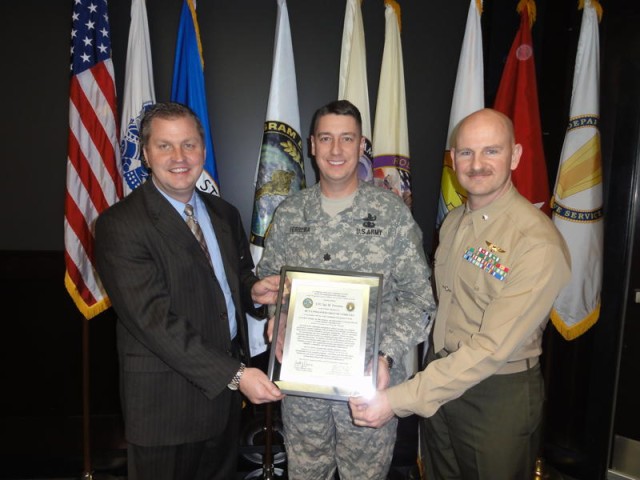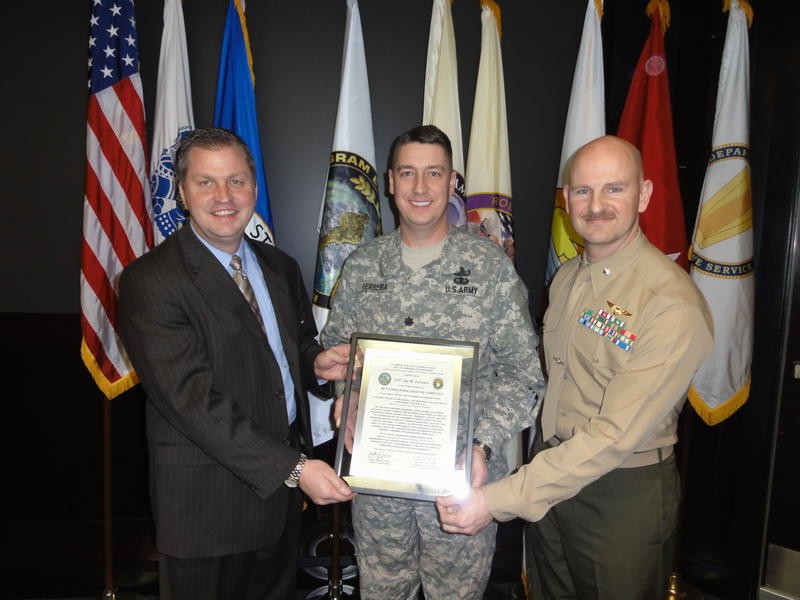A transition ceremony was held to formally transfer the Product Manager for Unmanned Ground Vehicles from the Program Executive Office Integration to the PEO Ground Combat Systems, Jan. 5, in Huntsville, Ala.
Maj. Gen. John Bartley, program executive officer, PEO I, transitioned the authority of the PdM UGV charter to Scott Davis, program executive officer, PEO GCS. Lt. Col. Jay Ferreira is the current incumbent and will continue to serve as the Product Manager for UGV under the authority of Lt. Col. (P) Dave Thompson, project manager, Robotic Systems Joint Project Office.
"You are witnessing a major consolidation in the field of military robotics," Thompson said. "With this change of charter, the RS JPO is now truly involved in every phase of the robotic acquisition life cycle and poised to support the Warfighter like never before."
PdM UGV consists of a government team that works closely with their prime contractors, Boeing and SAIC, to manage multiple programs - the Small Unmanned Ground Vehicle (XM-1216) and the Multifunction and Utility/Logistics Equipment (MULE) UGV which incorporates the Autonomous Navigation System (ANS).
Three subcontractors were awarded contracts to develop and deliver the following unmanned capabilities: iRobot was awarded the SUGV contract; Lockheed Martin was awarded the MULE; and General Dynamic Robotic Systems was awarded the ANS.
"We've got the Warren (RS JPO) contingent who have fielded thousands of robots to theater, which gives a lot of real-time experience, and you've got one of the best world-class engineering and development aspects of robotics here in this (PdM UGV) office," Davis said. "Putting the two back together again is just going to be phenomenal and very powerful in moving robotics forward in the Army, the Marine Corps and other agencies."
In 1988, the Army and Marine Corps formed the UGV JPO in Huntsville under a Congressional directive to consolidate Department of Defense efforts in developing battlefield ground robotic vehicles.
With the standup of PEO Future Combat Systems in the mid 2000s, authority for managing the SUGV, MULE and ANS were then aligned under the FCS organization, thus tying into overarching FCS development plan.
In order to support the ongoing wars in Iraq and Afghanistan, the rapid development of robotic systems continued under the newly designated RS JPO.
In 2005, the Base Realignment and Closure initiative directed by Congress moved the RS JPO and the associated Joint Robot Repair and Fielding activity to the Detroit Arsenal in Warren, Mich., to be collocated within PEO GCS. The transition of the PdM UGV to RS JPO is the result of the 2009 cancellation of the FCS program and the realignment of its component programs.
"Due to our history, we already have a very solid working relationship with the RS JPO," Ferreira said. "Our UGV development endeavors are unique within the Army and this relationship will further strengthen these efforts. There's significant potential on the horizon for the Army and the Marine Corps in the development of unmanned ground vehicles."
The robots already fielded and currently in development with the RS JPO support both the mounted and dismounted forces on the battlefield. In order for our Soldiers and Marines to dominate the enemy in complex environments, tactical units equipped with UGVs can employ a new operational paradigm with unprecedented capabilities and leading-edge technologies.
"Today's change of authority will give our organization more flexibility and a stronger voice to advocate for the Warfighter," Thompson said. "The UGVs currently in combat and being developed by the RS JPO team are revolutionizing the way the U.S. Army and Marine Corps fights and will give a decisive edge to our Warfighters in the future.


Social Sharing